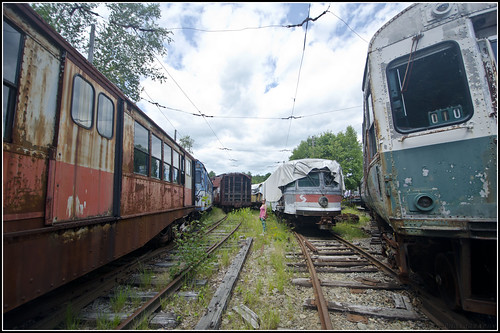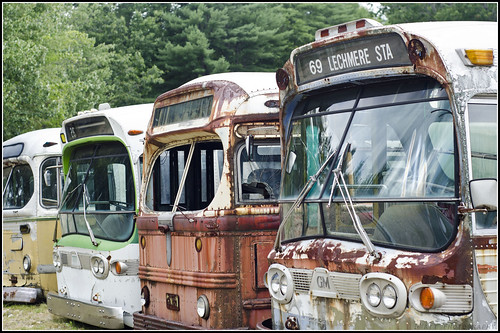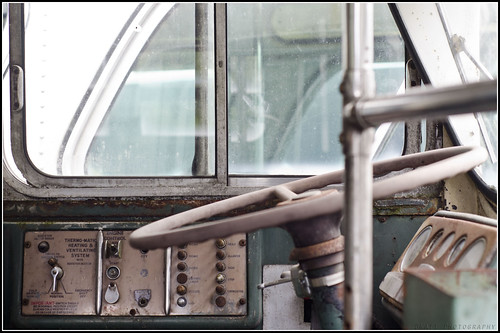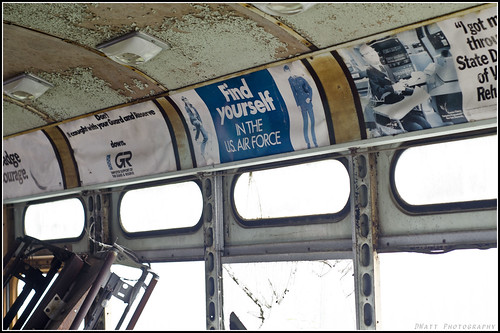From Derek Watt:
(Derek Watt took these great photos of a transportation graveyard somewhere in New England -- D.B.)




From Dave Brigham:
I don't have much to say about this place. It's been torn down since this Google Maps image was made. Located along Route 9 in Brookline, Mass., it was just a gas station, and not even a historic one (for some cool old gas Midwest gas stations, see June 6, 2012, "Fill 'er Up").
This is what it looks like now:


I haven't been able to find out what's going to be built here. Five years ago, the Chestnut Hill Neighborhood Association posted on its web site the following:
There is a "proposal to demolish the US Petroleum gas station on the northwest corner of Route 9 and Reservoir Road and replace it with a five-story masonry and glass medical/office use structure with retail space on the ground floor....Parking would be provided on three below-ground levels."
Stay tuned.
From Dave Brigham:
As a kid in the '70s tearing around my neighborhood and through the woods, I figured the bike I rode was an invention as old as time itself. There were no mountain bikes in those days, kids, just cruisers, three-speeds, five-speeds and ten-speeds that you rode anywhere and everywhere, treating them alternately like motorcycles, horses, moving trucks and, well, bicycles.
The history of two-wheeled transport goes back centuries, but the advent of what we recognize today as a bicycle began in the 19th century. For a time in the late 1800s and early 1900s, bicycle racing captivated America the way that NASCAR does today. And the fastest dirt bicycle racing track in the country was located in good ol' Waltham, Mass., the city I've written about more than any other on this blog.
Opened in 1893, Waltham Bicycle Park was the first track in Massachusetts built specifically for bike racing (others were also used for horse racing), according to this article on HubTrotter. Numerous world records fell at the park during its heyday.
The park had a grandstand and bleachers that could hold as many as 9,000 spectators. On opening day, more than 15,000 bike racing enthusiasts crammed the park, according to the HubTrotter article. According to a Boston Globe article, on opening day (and probably other days), people sat on the roofs of nearby buildings, as well as hills adjacent to the park.
Here's an illustration from the article:

Racing was very popular at this park, as at many others, but a serious accident, in which two racers were killed, in June 1900 put a damper on the enthusiasm. Two years later, the city of Waltham purchased the park and turned it into a football field. Nowadays, the site, known as Nipper Maher Park, includes Little League fields, tennis courts and a playground.
Here's what the park looks like now:

Here's a current shot of the hospital where some spectators may have watched races:

Here's a current shot of a hill behind where the grandstand once stood. Paths lead up to a neighborhood.

I just recently learned about the history of this park, so I set out to see what, if anything, remained from the bicycle racing facility that had so captured the attention of locals more than 100 years ago. When I saw some stone pieces in the woods and on the perimeter of the park, I thought perhaps they had been part of the grandstand.



It's hard to know what sort of structure these stones were part of. Are they simply leftovers from a more recent set of bleachers or small buildings. Anybody know, or have any guesses?
From Dave Brigham:

Is the word "teardown" in your town's lexicon? No? Well, then let me define it for you: "the process of buying an older, sometimes rundown house, knocking it flat to the ground and building an often oversized house in its place." What ever happened to renovation? My wife and I watch TV shows all the time where builders buy a house, take it down to the studs and turn it into a beautiful new place without the need to rip up a piece of a neighborhood's history.
Unbeknownst to me at the time, I lived in a future teardown in Newton, Mass., several years ago. Called La Casita Flatita (roughly translated as "the little flat house") by our landlord, a 70-something Italian-American guy who grew up in the house, the place was small, of course, but it was cute.
Our landlord's father built the house on a decent-sized lot that was cursed by a giant rock ledge that extended into the basement. He chipped away at the stone in there, our landlord said, to make the basement bigger. In the furthest part of the basement, where you had to duck your head, there was an old wine barrel. Our landlord's father grew his own grapes and made his own vino.
That's a great piece of history that I'll never forget. My wife, Beth, and I lived in the house for about two and a half years until our landlord told us he was going to put his childhood home on the market. Beth and I went back and forth about whether to make an offer. There were only two bedrooms and one bathroom, but it was on a quiet street that was walking distance to Newton Center, where there were stores, restaurants, banks and a trolley line. We were also right around the corner from two malls.
We decided to go for it, but our landlord rejected our offer. We decided to look elsewhere, and found a place not too far away, in the West Roxbury neighborhood of Boston.
We were sad to find out a few months later that the house had been sold to a developer, for not much more than we had offered. Before long, the house was leveled, the ledge blown up and two townhouses went up in its place. La Casita Flatita was gone, and so was its history.
Developers in Newton and surrounding towns have been mad for teardowns for years. I understand the economics: buy an out-of-fashion Cape or ranch house for $600,00-$700,000 (real estate around here is kinda crazy)....

...bulldoze the offending property and replace it with a much larger house that will sell for $1 million or more.***

Often times, the smaller homes are replaced with two or even three town houses, because the lots are decent sized and the zoning laws allow for this. Read this February 2015 Boston Globe Magazine article for more on teardowns in Newton and surrounding communities.
Also see our March 18, 2011, post, "Anatomy of a Teardown."
I'm not saying every old Cape, ranch or bungalow needs to be saved. I know that some places are simply beyond restoration, although Nicole Curtis might beg to differ with me on that. But when developers scoop up a house, erase the memories and history of that place, erect a bland structure with little architectural detail or sense of scale, and sell it to people who want a move-in ready home rather than being willing to put a bit of themselves into a place, it can be easy for neighbors to take offense.
The house at the top of this post was right around the corner from mine until about a year and a half ago. A nondescript brick ranch house, it was leveled, with the exception of one wall, and a new, multi-gabled house went up in its place. Eventually that one wall was torn down -- I imagine this had something to do with zoning/teardown regulations in Newton.
Within the last year or so, several other houses in the vicinity have been knocked down, along with dozens across the city of Newton.

The house that once stood here was featured in a John Travolta movie, "The Forger." Here's a brief article about the shoot, featuring a photo of the place.
Any smart developer/realtor could have squeezed some extra cash out of a potential buyer if they mentioned this fact. But no, somebody tore the damn thing down and put up a house that wasn't in a movie, and most likely won't ever be.
The place below was built in 1920, and purchased for $500,000 in May of this year.

When I saw this piece of heavy machinery parked in the yard, I knew the house's days were limited, despite my wife's insistence that somebody might just be planning a renovation.

The house was emptied first, and the prior owner's belongings were plowed into a big, dirty mess.

Still, amid the rubble there was life, personality, a sense of who the former owner was.

In November 2014, the Newton Board of Aldermen voted to reject a proposed moratorium on teardowns involving homes greater than 120% of the original structure’s floor area.
The primary argument against teardowns comes down to economics: by taking potential starter homes (albeit fairly expensive ones compared to towns a bit further out from Boston) off the market, these developers are catering to a certain class of folks -- rich ones.
As a liberal and someone who loves old homes (mine is from the early '20s), I agree with these arguments against allowing one home to be demolished and replaced with a McMansion or two or more expensive townhouses. At the same time, I don't think you can legislate against developers trying to maximize their profits. I hope there's a meeting place for the two sides in this argument, but rezoning neighborhoods and reworking the details of a replacement house's footprint are big issues that few in Newton's government want to take on.
***These houses are both currently in Newton's Oak Park neighborhood; I offer these photos as an example of the types of houses being torn down, and what replaces them.
From Kris Smith:
Wisconsin isn’t an old state, relatively speaking; it’s only been one since 1848. To this native New Englander, the Badger State is pretty new, and the differences between regions are interesting. New Hampshire has way more old cemeteries, but a lot fewer abandoned buildings. With this find, I got both. Kind of.

This is the country’s first and oldest Estonian Lutheran church. It was built in Gleason around 1914 or 15 by immigrants fleeing Russian oppression, who decided the Wisconsin River Valley would remind them of their lost homeland and provide plenty of farm and timber land. The congregation was only about 30, but the church, once they built it, became their community center. The cemetery was consecrated before the church went up. Eleven of the original 14 interments remain and many have new markers, although I preferred to photograph one of the originals.

They had an altar, pews and a lectern; all made with rough-hewn planks. Women sat on one side of the aisle, men on the other. Decoration came from their own hands or gardens. What they didn’t have was a bell. Bell-lessness didn’t last long; soon Sears & Roebuck sent “one of their smallest bells” as a result of a donation request from church elders, who stated that Estonians were good customers and the company should give them a bell.
The church saw sporadic, but consistent use by the Estonian immigrants for the next half-century, but tragedy struck soon after the 50th Anniversary celebration. Vandals began to desecrate and destroy the tiny building. Everything was smashed or stolen, including the much-loved bell. In 1970 the people decided to board up their church and leave it alone, figuring that if something looked unloved and useless the vandals would leave it alone. They were right.
Today the church stands alone in its clearing. Some renovation has been done over the years with efforts to preserve the rustic little building. It’s charming and sad and once again has no bell.
From Dave Brigham: On my second trek through my father's hometown of Springfield, Mass., I started a few blocks northeast of the Metro...
